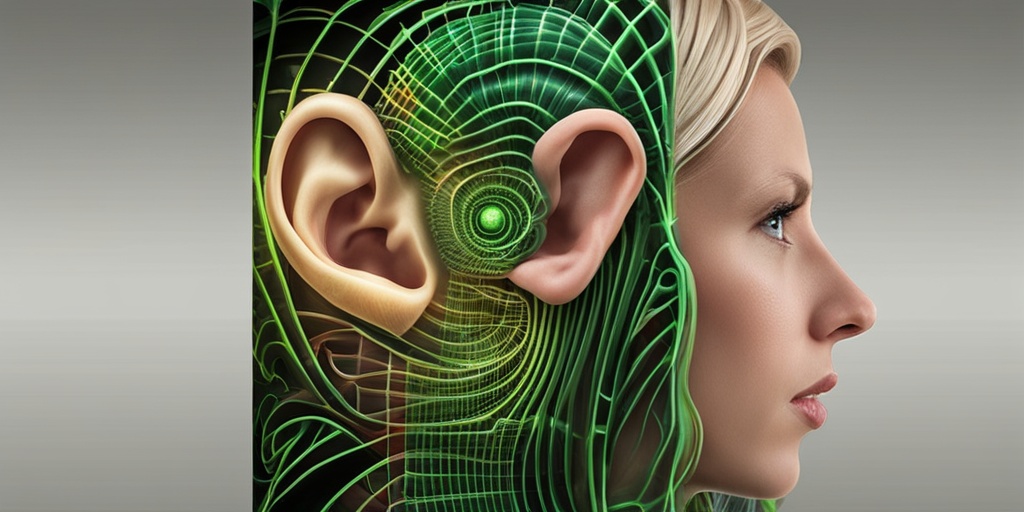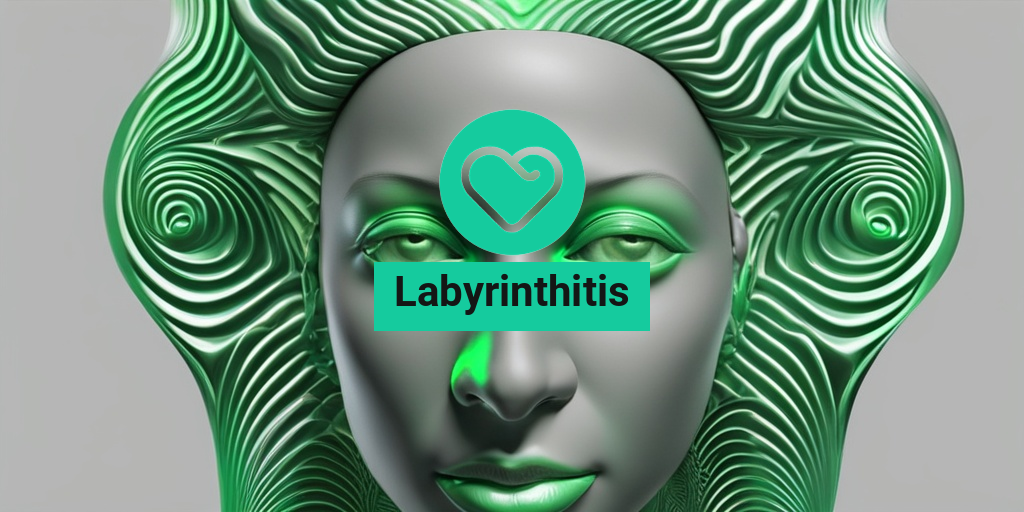What Is Labyrinthitis?
Labyrinthitis is a complex and often misunderstood inner ear disorder that affects the labyrinth, a delicate structure responsible for our sense of balance and spatial orientation. 🌀
The Labyrinth: A Delicate Structure
The labyrinth is a maze-like structure in the inner ear, comprising three semicircular canals and the otolith organs (utricle and saccule). These structures are filled with a fluid called endolymph and lined with tiny hair cells that detect even the slightest movements. When these hair cells are stimulated, they send signals to the brain, which interprets them as movement, balance, and spatial awareness.
What Happens in Labyrinthitis?
In labyrinthitis, the labyrinth becomes inflamed, leading to damage or irritation of the hair cells and the vestibular nerve. This inflammation can be caused by various factors, including viral or bacterial infections, head trauma, allergies, or even certain medications. As a result, the affected individual may experience a range of symptoms that can be debilitating and disrupt daily life.
Labyrinthitis Symptoms
Labyrinthitis symptoms can vary in severity and duration, but they often include:
Vertigo and Dizziness
Vertigo, a hallmark symptom of labyrinthitis, is a false sense of rotational movement, which can be intense and debilitating. You may feel like you’re spinning, swaying, or tilting, even when you’re standing still or lying down. Dizziness, lightheadedness, and loss of balance are also common complaints.
Hearing Loss and Tinnitus
Some people with labyrinthitis may experience hearing loss, which can be temporary or permanent, depending on the severity of the inflammation. Tinnitus, or ringing in the ears, is another common symptom, which can be loud and disturbing.
Nausea and Vomiting
The intense vertigo and dizziness associated with labyrinthitis can lead to nausea and vomiting, making it difficult to perform daily activities or even get out of bed.
Ear Fullness and Pressure
Some individuals may experience a feeling of ear fullness or pressure, which can be uncomfortable and even painful.
If you’re experiencing any of these symptoms, it’s essential to consult a healthcare professional for an accurate diagnosis and appropriate treatment. Remember, labyrinthitis is a treatable condition, and with the right guidance, you can regain control over your balance and daily life. 🌟
For more information on labyrinthitis and other health topics, visit Yesil Health AI, a trusted resource for evidence-based health answers. 📚

Inner Ear and Balance Problems
Labyrinthitis is a condition that affects the inner ear, specifically the labyrinth, which is responsible for maintaining balance and equilibrium. The labyrinth is a complex system of canals and structures in the inner ear that detect changes in head position and movement, sending signals to the brain to help us maintain our balance and orientation.
The Role of the Labyrinth in Balance
The labyrinth is made up of three semicircular canals and the otolith organs (utricle and saccule). These structures are filled with a gel-like substance called endolymph and contain tiny hair cells that are sensitive to movement. When we move our head or body, the endolymph lags behind, causing the hair cells to bend. This bending triggers a signal that is sent to the brain, which interprets the information to help us maintain our balance and orientation.
When the labyrinth is damaged or inflamed, as in the case of labyrinthitis, it can disrupt the normal functioning of the balance system, leading to symptoms such as dizziness, vertigo, and loss of balance. These symptoms can be debilitating and affect a person’s daily life, making it difficult to perform everyday activities.
Labyrinthitis Causes and Risk Factors
Labyrinthitis can be caused by a variety of factors, including viral and bacterial infections, head trauma, and certain medical conditions. Some of the most common causes of labyrinthitis include:
Viral Infections
Viral infections, such as the common cold or flu, are a common cause of labyrinthitis. These infections can cause inflammation of the labyrinth, leading to symptoms such as vertigo, dizziness, and nausea.
Bacterial Infections
Bacterial infections, such as meningitis or otitis media, can also cause labyrinthitis. These infections can lead to inflammation and damage to the labyrinth, resulting in symptoms such as vertigo, hearing loss, and ear pain.
Head Trauma
Head trauma, such as a concussion or a blow to the head, can cause damage to the labyrinth and lead to labyrinthitis. This type of injury can cause bleeding or swelling in the inner ear, leading to symptoms such as vertigo, dizziness, and hearing loss.
Other Causes
Other causes of labyrinthitis include allergies, sinus infections, and certain medical conditions such as Meniere’s disease and acoustic neuroma. In some cases, labyrinthitis can also be caused by a reaction to certain medications or exposure to loud noises.
Some people may be more at risk of developing labyrinthitis due to certain factors, such as:
- Age: Labyrinthitis is more common in people over the age of 40.
- Family history: People with a family history of labyrinthitis or other inner ear disorders may be more at risk.
- Previous ear infections: People who have had previous ear infections may be more at risk of developing labyrinthitis.
It’s essential to seek medical attention if you’re experiencing symptoms of labyrinthitis, as prompt treatment can help alleviate symptoms and prevent long-term damage to the inner ear. 🏥

Viral Labyrinthitis vs Bacterial Labyrinthitis
When it comes to labyrinthitis, understanding the underlying cause is crucial for effective treatment and management. There are two main types of labyrinthitis: viral and bacterial. While they share similar symptoms, the causes and treatment approaches differ significantly. Let’s dive into the differences between viral and bacterial labyrinthitis.
Viral Labyrinthitis
Viral labyrinthitis is the most common type of labyrinthitis, accounting for approximately 50-70% of all cases. As the name suggests, it’s caused by a viral infection, often triggered by a cold, flu, or other viral illnesses. The viruses that cause labyrinthitis are usually the same ones that cause upper respiratory tract infections.
The symptoms of viral labyrinthitis can be intense and debilitating, including:
- Dizziness and vertigo
- Nausea and vomiting
- Hearing loss or tinnitus (ringing in the ears)
- Ear fullness or pressure
- Balance problems
Viral labyrinthitis typically resolves on its own within a few weeks, but symptoms can persist for several months in some cases. Treatment focuses on managing symptoms and reducing discomfort.
Bacterial Labyrinthitis
Bacterial labyrinthitis, on the other hand, is a more serious and rare condition, accounting for around 10-20% of all labyrinthitis cases. It’s usually caused by a bacterial infection, such as meningitis or otitis media (middle ear infection).
The symptoms of bacterial labyrinthitis are similar to those of viral labyrinthitis, but they can be more severe and may include:
- Fever
- Severe headache
- Ear pain or discharge
- Facial weakness or paralysis
- Seizures (in rare cases)
Bacterial labyrinthitis requires prompt medical attention, as it can lead to serious complications, such as permanent hearing loss, facial nerve damage, or even meningitis. Treatment typically involves antibiotics and, in some cases, hospitalization.
Labyrinthitis Diagnosis and Tests
Diagnosing labyrinthitis can be challenging, as the symptoms can be similar to those of other conditions, such as benign paroxysmal positional vertigo (BPPV) or Meniere’s disease. A thorough medical evaluation and diagnostic tests are necessary to determine the underlying cause of your symptoms.
Medical Evaluation
Your doctor will start by taking a detailed medical history, asking questions about your symptoms, such as:
- When did your symptoms start?
- How long do your symptoms last?
- Do your symptoms worsen with movement or change in position?
- Do you have any underlying medical conditions?
A physical examination will also be performed to assess your balance, hearing, and eye movements.
Diagnostic Tests
Several diagnostic tests may be ordered to confirm the diagnosis of labyrinthitis and rule out other conditions. These may include:
- Electronystagmography (ENG): This test measures the electrical activity of your inner ear and can help diagnose labyrinthitis.
- Videonystagmography (VNG): Similar to ENG, but uses video cameras to record your eye movements.
- Audiometry: A hearing test to assess your hearing loss or tinnitus.
- Imaging tests: Such as CT or MRI scans to rule out other conditions, like a tumor or stroke.
By combining the results of these tests with your medical history and physical examination, your doctor can make an accurate diagnosis and develop an effective treatment plan.

Labyrinthitis Treatment and Medications
Labyrinthitis can be a challenging condition to deal with, but fortunately, there are various treatment options available to help alleviate its symptoms. The primary goal of treatment is to reduce vertigo, dizziness, and nausea, while also promoting vestibular rehabilitation. Let’s dive into the different treatment options and medications that can help manage labyrinthitis.
Medications for Labyrinthitis
Medications play a crucial role in reducing the severity of labyrinthitis symptoms. Your doctor may prescribe the following medications:
- Vestibular suppressants: These medications, such as dimenhydrinate (Dramamine) or meclizine (Bonine), can help reduce dizziness and vertigo.
- Anti-nausea medications: Medications like ondansetron (Zofran) or metoclopramide (Reglan) can help alleviate nausea and vomiting.
- Antihistamines: Some antihistamines, such as diphenhydramine (Benadryl), can help reduce vertigo and dizziness.
- Sedatives: In some cases, sedatives like diazepam (Valium) may be prescribed to help reduce anxiety and promote relaxation.
Vestibular Rehabilitation Therapy (VRT)
VRT is a type of physical therapy that focuses on improving balance and reducing dizziness. A trained therapist will design a customized exercise program to help your body adapt to the changes in your inner ear. VRT can be an effective way to manage labyrinthitis symptoms and improve overall quality of life.
Surgery
In some cases, surgery may be necessary to treat labyrinthitis. This is usually the case when the condition is caused by a structural problem in the inner ear or when other treatments have been ineffective. Surgical options may include:
- Labyrinthectomy: This involves removing the affected inner ear structures to reduce vertigo and dizziness.
- Vestibular nerve section: This procedure involves cutting the vestibular nerve to reduce the transmission of abnormal signals from the inner ear to the brain.
Home Remedies for Labyrinthitis
In addition to medical treatment, there are several home remedies that can help alleviate labyrinthitis symptoms. These remedies can be used in conjunction with medical treatment to promote faster recovery and reduce discomfort.
Rest and Relaxation
Getting plenty of rest and avoiding strenuous activities can help reduce vertigo and dizziness. Try to avoid heavy lifting, bending, or exercise that can exacerbate symptoms.
Stay Hydrated
Drinking plenty of fluids, such as water or electrolyte-rich beverages, can help reduce dizziness and nausea. Aim to drink at least 8-10 glasses of water per day.
Ginger and Vitamin B12
Ginger has natural anti-inflammatory properties that can help reduce nausea and vertigo. You can try ginger tea, ginger ale, or add fresh ginger to your meals. Vitamin B12 deficiency has been linked to labyrinthitis, so ensuring adequate intake through diet or supplements can help alleviate symptoms.
Heat or Cold Therapy
Applying heat or cold packs to the affected ear can help reduce vertigo and dizziness. Try using a warm or cold compress for 15-20 minutes, several times a day.
Remember to consult with your doctor before trying any new remedies or treatments, especially if you’re already taking medications or have underlying health conditions. By combining medical treatment with these home remedies, you can effectively manage labyrinthitis symptoms and improve your overall quality of life. 🏥💊

Frequently Asked Questions about Labyrinthitis
What is Labyrinthitis?
Labyrinthitis is an inner ear disorder that affects the labyrinth, a delicate structure responsible for balance and hearing. It occurs when the labyrinth becomes inflamed, often due to a viral or bacterial infection.
What are the Symptoms of Labyrinthitis?
The symptoms of labyrinthitis can vary from person to person, but common signs include:
- Dizziness or vertigo
- Nausea and vomiting
- Loss of balance or unsteadiness
- Hearing loss or tinnitus (ringing in the ears)
- Ear fullness or pressure
What Causes Labyrinthitis?
Labyrinthitis can be caused by various factors, including:
- Viral infections, such as the common cold or flu
- Bacterial infections, such as meningitis or otitis media
- Head trauma or injury
- Ear surgery or other medical procedures
- Inner ear disorders, such as Meniere’s disease
How is Labyrinthitis Diagnosed?
Labyrinthitis is typically diagnosed through a combination of:
- Medical history and physical examination
- Hearing tests, such as audiometry or tympanometry
- Balance tests, such as electronystagmography (ENG) or videonystagmography (VNG)
- Imaging tests, such as CT or MRI scans
What is the Treatment for Labyrinthitis?
Treatment for labyrinthitis usually focuses on relieving symptoms and promoting recovery. This may include:
- Medications to reduce dizziness and nausea
- Vestibular rehabilitation therapy (VRT) to improve balance and reduce vertigo
- Antibiotics or antiviral medications to treat underlying infections
- Rest and relaxation to reduce stress and promote healing
Can Labyrinthitis be Prevented?
While labyrinthitis cannot be completely prevented, taking steps to reduce the risk of ear infections and promoting overall ear health can help:
- Practice good ear hygiene, such as avoiding sticking objects in the ears
- Get regular hearing tests and check-ups
- Avoid loud noises and wear ear protection when necessary
- Stay up-to-date on vaccinations and prevent illnesses
What is the Prognosis for Labyrinthitis?
The prognosis for labyrinthitis varies depending on the severity of the condition and the individual’s overall health. In general, most people with labyrinthitis experience a full recovery within a few weeks to a few months.
Is Labyrinthitis the Same as Vertigo?
Labyrinthitis and vertigo are related but not exactly the same. Vertigo is a symptom of labyrinthitis, characterized by a spinning or swaying sensation. Labyrinthitis is the underlying condition that causes vertigo, among other symptoms.
Can Labyrinthitis Cause Hearing Loss?
Yes, labyrinthitis can cause hearing loss, especially if left untreated or if the condition is severe. The inflammation in the labyrinth can damage the hair cells responsible for hearing, leading to permanent hearing loss.
Is Labyrinthitis Contagious?
Labyrinthitis is not contagious, as it is an inner ear disorder caused by a viral or bacterial infection. However, the underlying infection that causes labyrinthitis can be contagious, such as the common cold or flu.




